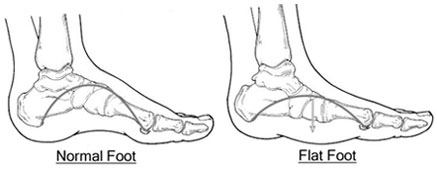WHAT IS A FLAT FOOT?
A flatfoot is the collapse of the medial longitudinal arch or the “arch of the foot” as most know it. The most common type of flatfoot is the flexible flatfoot. In many individuals the process begins childhood and continues into adulthood without being diagnosed. For some children it will bring on symptoms of foot fatigue and pain. Parents will notice their child being less active. Other children will go onto adulthood without symptoms until some later date where finally the condition begins to hinder their daily activity. As the deformity worsens the soft tissue that holds the arch becomes increasingly stretched and inflamed. A flexible flatfoot is termed as such due to the return of the arch when the individual is not standing on the foot. In the early stages the return of the arch is possible because arthritis of the joints have not set in. Once the arthritic process begins, the joints become restricted and the foot will stay flat even when not weight bearing. Some of the symptoms of a flatfoot include pain in the heel, arch, ankle or along the outside of the foot. Also general weakness and fatigue of the foot and leg are noted.
HOW ARE FLAT FEET DIAGNOSED?
We will perform a detailed history with a thorough physical examination of the foot. After observing the patient stand and ambulate, we will also take X-rays in the office to determine the severity of the flatfeet. This will allow us to determine if the arthritic stage of this process has begun.
 WHY DO I HAVE A FLAT FOOT?
WHY DO I HAVE A FLAT FOOT?
There are many ideas as to why individuals develop flatfeet. They include muscular or ligamentous weakness, joint instability, and biomechanical compensation for deforming forces of the body. Recently there have also been ideas that might lead us to believe that there are genetic predispositions to the condition.
HOW CAN I TREAT THIS PROBLEM?
Over the counter arch support and wearing shoes that prevent over pronation of the foot can help. Over pronation is the internal rolling of the foot that pushes the arch to contact the ground.
WHAT WILL MY DOCTOR DO FOR THIS PROBLEM?
After a thorough history and physical we will recommend a variety of conservative treatments for flatfeet. This will include activity modification, weight loss (if needed), orthotic devices, for more severe cases we have ankle foot orthoses, medications, physical therapy and shoe modifications. The mainstays of our conservative approach are functional custom orthotics that we can custom manufacture and prescribe for your specific foot type. They are devices that are placed in your shoes and are not noticeable by others. Orthotics compensate for mechanical faults and allow your feet to function with improved efficiency. Orthotics relieve stress from compromised joints, ligaments, and muscles of the lower extremity.
If conservative management fails and the symptoms are not subsiding or if there is an acute injury that is causing the flatfoot, then surgery is recommended. Among the many procedures available to us for correction of a flatfoot, are implant procedures to restore the arch, fusions of joints, and tendon realignment and transfers that will correct the position of the foot. We can also manipulate and move bones that are mal-aligned. Recovery for each procedure varies depending on the procedure and the individual.
CAN I PREVENT IT FROM HAPPENING AGAIN?
Early detection in childhood is important. We can treat the condition and slow down if not completely prevent the progression into the arthritic stages of the deformity. Therefore if there is a question as to whether your child has a flatfoot, please bring them into see a Podiatric specialist for evaluation. The small amount of time that you invest can save the child a lifetime of possibly crippling problems.

